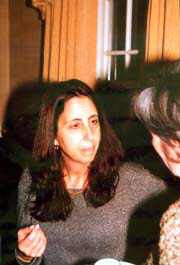Hoboken resident Leslie Rubman knows what kidney disease looks like.
In the early 1980s, her mother was diagnosed Polycystic Kidney Disease (PKD), and for most of the next two decades, Rubman and her three siblings watched their mother slowly die. Her mother finally succumbed in 2002.
Now Rubman’s older sister, Ellen Somberg, 52, “the glue of the family” as she calls her, has the same genetic disease and is waiting for a transplant.
Until then, Somberg, who lives in Tenafly with three children ages 17 to 23, spends much of her day attached to a dialysis machine that is needed to keep her alive.
“She’s been so courageous through this entire thing,” said Rubman. “She is such as strong person, she leads a full life, but even she knows it’s an uphill battle.”
PKD is an inherited disorder. Each child of an autosomal-dominant PKD parent has a 50 percent chance of inheriting the disease. According the PKD Foundation, a normal kidney is the size of a human fist. However, with the presence of PHD, cysts develop in both kidneys. Cysts are sacks of fluid that cause the kidney to enlarge, hindering its filtering ability.
Ultimately, the diseased kidney shuts down, causing end-stage renal disease for which dialysis and transplants are the only forms of treatment.
What might be most surprising is that there are more persons with PKD than the combined numbers of those with cystic fibrosis, muscular dystrophy, hemophilia, Down’s syndrome, and sickle cell anemia, combined.
In fact, according the PKD Foundation, PKD affects 600,000 Americans and 12.5 million people worldwide, making it the most common life-threatening genetic disease. It’s two times more common than multiple sclerosis and 20 times more common that cystic fibrosis.
In Rubman’s case, she is the only one of her four siblings who doesn’t have PKD. The symptoms don’t normally appear until around the 50th year of life. Somberg started showing symptoms when she was 48. Their two youngest siblings, who are 42 and 46, have yet to show symptoms, but likely will in a couple of years.
For this family, it’s been a struggle to overcome this genetic disease.
“The ups and downs, on seemingly a daily basis, have been tremendously difficult,” said Rubman.
Transplant
Then came a beacon of hope when in December of 2000 doctors at the Mayo Clinic found Rubman’s kidney to be a perfect match for her sister.
“We saw the light at the end of the tunnel,” said Rubman. But that hope was temporality dashed in Summer of 2002 when the same doctors told her that she had “low kidney function,” and her kidney could not be given to her sister.
“I was crushed when they told me that,” she said. “I would do anything to give one of my kidneys to my sister.”
Rubman’s kidneys function fine for her and do not have PKD or any other kidney disease, but they just don’t function well enough to make her a suitable donor. So Somberg put her name on every waiting list she could, and waited.
Then in early 2003, there was good news again. A match was found from an organ donor, and Somberg had a kidney transplant. But her body rejected the kidney, making dialysis once again a part of her daily routine.
Hope from ‘Zo
But there is hope on the horizon. Kidney disease has recently been in the spotlight after former-NBA superstar Alonzo Mourning, suffering from a different kidney disease, received a transplant from his cousin. In fact, more than 500-people volunteered to donate their kidney to the star.
Now Mourning has become a vocal advocate in helping find kidneys for non-celebrities. In fact, on the day he was released from the hospital after his transplant, he read to the press a letter from Ellen’s 17-year-old daughter Molly Somberg. She wrote that her grandmother died of a kidney disease and that her mother had the same disease and was waiting for a transplant.
After reading the letter aloud, Mourning issued an impassioned plea for organ donation, according to a New York Times story. He asked those who had offered him a kidney to donate to less-famous patients.
According to the Times story, while recovering from surgery, Mourning read the autobiography of cyclist Lance Armstrong, who has won the Tour de France five times since surviving cancer. While reading it, Mourning used Stromberg’s letter as a bookmark.
What you can do
Rubman said the first and easiest thing that everyone should do is sign up to become an organ donor. This can be done at the Department of Motor Vehicles, and is easy to do when renewing your drivers’ license. Every year, hundreds of people die while waiting for a transplant, and many others lose their lives before they even get on to the waiting list. There is a serious shortage of organs, and the gap between the number of organs donated and the number of people waiting for a transplant is increasing.
According to the Center for Liver and Kidney Diseases and Transplants, traditionally, “cadaver” organ donors (i.e., a healthy person who died suddenly after an accident or illness) were exclusively utilized for kidney transplants. However, due to a shortage of “cadaver” donor organs, the number of patients waiting for a kidney transplant in the United States has grown dramatically over time.
So there is more of a need for living kidney donors.
To be a donor one must be an adult, in good health, with a blood type that is compatible with that of the recipient. In addition, both of the donor’s kidneys must be healthy in order to ensure that the donation of one kidney is not harmful for the donor.
For more information on being a living donor, e-mail Leslie Rubman at LTrubini@hotmail.com or search the web at www.livingdonoronline.org. To learn more about Rubman, call (201) 745-7963. To learn more about PKD go to www.pkdcure.org or www.renalnet.org.
